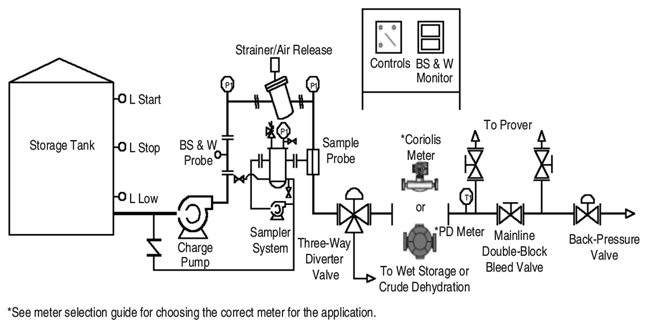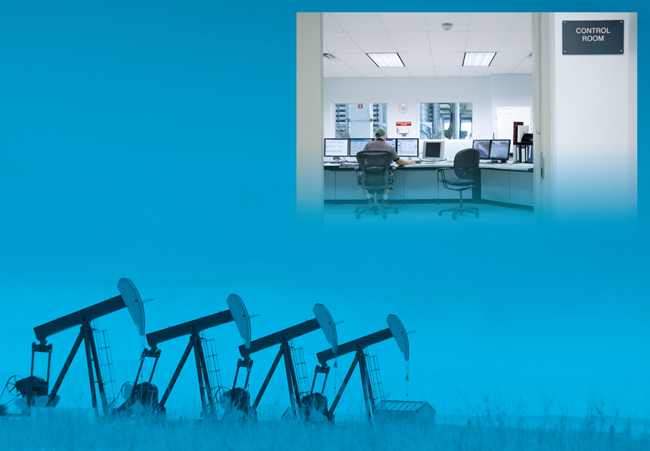
Production Automation
Automation Solutions Optimize Performance Of Multiwell Pads
By Daniel G. Steele
BOULDER, CO.–Over the past few years, the vast majority of new wells in unconventional formations have been drilled, completed and produced on multiple-well pads. In fact, operators are now designing pads with 20 or more horizontal wellbores, using batch drilling and simultaneous completion operations to significantly improve efficiencies and slash individual well costs by as much as 35 percent.
In plays such as the Bakken, Eagle Ford, Permian, Marcellus, Niobrara and Woodford, oil and gas companies are investing considerable resources in not only developing well pads, but also in equipping each producing pad and building out gathering systems and installing centralized facilities to accommodate the production streams, which are often multiphase with varying combinations of gas and liquids.
Increasingly, sophisticated automation and remote monitoring are required of the vast equipment needed to efficiently produce from such sites, and fortunately, provide a powerful solution for improving pad production economics.
Operators face a number of technical challenges in producing from pad sites. Steep decline rates that lead to highly variable flow rates, a wide variety of equipment types to handle gas and liquids production, and the scale of operations related to the production, gathering and treating/processing facilities are among the factors that make managing pad developments in resource plays so complex.
It’s a given that the technical and operational challenges are stressed by today’s low commodity prices. Similarly, there is no question that leading-edge automation technologies provide superior economic performance of producing assets, regardless of prevailing price environments.
Because of the sheer number of wells and the amount of production, treating, separation, compression and storage equipment concentrated on a pad to accommodate production flows from multiple wells, a substantial increase in networking and automation technology is required. However, automation can do more than simply support the growth of production operations. Choosing the right system can give operators the potential to respond more effectively to the challenges presented both by near-term market uncertainties and long-term operational trends.
New Standard
For automation management personnel, the industry’s move to multiwell pads as the new standard for developing tight oil and gas shale plays creates challenges as well as opportunities. Pad operations drive the need for new ways to automate and combine production technologies. The biggest requirement that has changed for most oil and gas companies is the need for “on-demand” data gathering.
Live data are now the norm instead of the exception. Companies need real-time visibility into what field assets are doing all the time and to receive live data from fields, personnel, wells, storage facilities, etc. The ability to make decisions very quickly is the key to success in today’s marketplace, especially given continual changes to economic, environmental and legal conditions.
Real-time automation and communications provide the capability to monitor, control and enhance production operations through smarter networks that can be accessed anytime and anywhere using smart phones, tablets and personal computers. Indeed, wireless communications are the central nervous system that supports the automation requirements needed to give operators reliable real-time information for optimizing production.
Many of the first multiwell pads used a single large flowmeter or controller (remote terminal unit or programmable logic controller) capable of handling multiple wellheads. In most cases, the wells were brought on line at different times and the automation capacity was added incrementally as wells were hooked up and the amount of on-site equipment and storage tanks increased. It did not take long for this approach to prove problematic.
Moreover, these systems were often hard wired, with cabling from each wellhead and storage tank to the central controller buried across a location. The activity and traffic related to ongoing drilling and completion operations, as well as transporting liquids off location, can ravage buried cables and cause wiring to become nonfunctional. In some cases, buried cable had to be replaced in less than one year, creating an unnecessary and time-consuming expense.
By eliminating cables, wireless systems ensure that automation and communications technicians do not have to make frequent repairs or replacements of networks or systems that do not work properly. Instead, personnel are able to focus their schedules on maintenance needs and keeping up with dynamic production trends. A wireless system should be cost effective (less than a comparable wired solution), easy to install, dependable and maintenance free, easy to use, and fail-safe to allow valve closure if communications are lost.
Oil and gas companies are rethinking how they install their field networks, partly because of the sheer number of wells that have been brought on production, along with the number of wired and wireless communication devices that are in place already. The radio frequency noise floor has to be managed more efficiently by creating smaller networks or “pods” that communicate shorter distances and use less output power and smaller gain antennas (that change polarity) to perform better.
Operators are building and operating both individual sets of production facilities per pad as well as centralized facilities to treat oil and gas flows from multiple pads. In fact, automation and real-time data communications are being used for more than production in many cases.
For instance, the ability to measure the amount of water being used during hydraulic fracturing has become critical. Another example is lease automated custody transfer, as shown in Figure 1. Oil and gas companies and their partners need accurate and timely data from customer transfer metering locations. With per-well intial productivities dramatically increasing as the industry continues to perfect horizontal drilling and fracturing designs, more and more production departments are looking to third-party transportation companies to manage the transfer of liquids in areas with pipeline capacity constraints.
This again creates challenges because data must be shared in an accurate and timely manner not only internally, but also outside the operator’s corporate firewall to allow trucking companies to monitor tank levels in real time, coordinate the logistics of transporting liquids off location, and verify volumes offloaded for transport.
Finding The Best Fit
Manufacturers have risen to the challenge of creating new solutions to solve multiwell pad automation challenges, and dozens of wireless instrumentation products are now available. Each manufacturer has taken a somewhat different approach to solving these challenges, and finding the right solution is about understanding each system’s capabilities and how they can be matched to the specifications of a particular application.
There are several issues for an operator to consider when determining the right fit. They include the data protocol (modbus is the most common protocol for wellhead communications), the number of remote input/output points needed to monitor each pad (tanks, number of wellheads, water meters, electrostatic discharge devices, separators, vapor recovery systems, flare stacks, etc.), and the number of I/O points at each wellhead (casing pressure, tubing pressure, surface pressure, intermediate pressure, valve control, plunger arrival, etc.).
In addition, the operator needs to be sure a system allows multiple devices to be terminated on one I/O board, and that it supports call-out alarm notifications and simple network management protocol traps. It also is important to investigate the type of RTU or PLC that will be used, the requirement for a data hub, compatibility with other radio systems for long-range data collection (eliminating interference), and the use of network management software to monitor the entire network.
Since wireless networks on a single pad are independent of one another, it creates an opportunity to install different solutions on separate pads on a trial basis as a way to compare performance. These kinds of test runs can be very valuable for evaluating how issues such as interference and “cross-talking” differ from one system to another. After all, there is no substitute for field trials. The real world has a way of very quickly sorting out the technology that best fits a given application.
Many unconventional gas assets either do not have electric power or have limited power availability at the well, so solar and batteries are important and need to be designed, based on the area where they will be installed. Other ways to provide real-time information at the wellhead include video, voice, well data and conditions (both during the drilling and completion process and after).
In addition, WiFi hot spots at well or field locations for local area network capability and wireless connectivity are crucial to communicating oil and gas production (i.e., “cash register”) information, and the integrity of those field assets is critical. The ability to track and know where field personnel are, which technicians can respond to a maintenance issue, or where assets have been relocated also is important. It is all about time and being able to react or be proactive almost instantly.
Hybrid Solutions
As automation has evolved on pad sites, it has become common for operators to create hybrid solutions that combine Ethernet, serial and wireless layers of communications. Ethernet allows the producer to have multiple people and departments access the same dataset, and lets the enterprise system poll multiple locations at once. Because Ethernet has Internet protocol addressability, each point in the system has a unique address and conversations can be routed to and from each address.
Hybrid automation and data communications solutions help operators respond to the challenges presented by near-term uncertainties as well as longer-term operational objectives to better manage the production performance of multiwell pads in unconventional resource plays.
Optimizing production requires data to be recorded in real time and transmitted many times each day. With the latest generation of RTU and PLC technology, these data can be collected on location through wireless I/O radios as frequently as once a minute if desired, and then sent to the host every hour to provide the granularity necessary to produce trend analysis at a level that is meaningful for production optimization purposes.
The serial communication layer is typically RS-232 or RS-485 communiation protocol. Serial protocols consume much less power than Ethernet radios, so combining serial with Ethernet at a data concentration spot can create fast, yet low power-consuming systems. The wireless layer provides the I/O communications between the wellhead and the RTU or PLC. While a modbus communication in most cases, it also can be an instrumentation-level signal.
To illustrate how a hybrid system functions, consider a hypothetical case where a system integrator needs to communicate with each well several times per minute accross an asset with 200 pumping oil wells. By combining technologies and using a layered communications aproach to create a best-fit solution, the system can have the functionality to provide alarms, pump control, automatic flow shut-off to full tanks, and accurate data archival on flow rates and liquid transport volumes while allowing authorized users to view real-time data to meet their requirements without having to visit 200 pumping wells.
Capturing Opportunities
The decline in oil prices and lingering softness in the natural gas market only compound the challenges associated with maintaining production from multiwell pads. Automating operations and acquiring field status and production data are even more important as companies streamline to maintain profitability. To make sound decisions, operators need easy and quick access to production data, along with the ability to better monitor gathering, storage and central treating facilities.
How long commodity prices will remain at current levels is anyone’s guess, but the million-dollar question for operators is how quickly they will be able to make critical decisions in response to changing market conditions. Field knowledge and access to data are the keys. Oil and gas companies need this intelligence within a time frame that allows them to make actionable business decisions to both proactively optimize production and react to shifting market conditions to capture opportunities.
Multiwell pads represent the future of drilling and production, and underscore the need for effective automation and data access. Oil and gas measurement and automation technicians, and field engineers, have been tasked with retriving more data much more quickly to enable real-time optimization. This trend is leading to a number of technological innovations in both automation and data communciations.
But just as every well and play are somewhat different, each application of production automation technology also has it owns requirement, making a universal solution an impossibility. Understanding what really is needed in terms of real-time data is vital to success. For most operators, the right approach combines several layers of communications to achieve the desired result at a reasonable cost.
The bottom line is that operators want to receive all their data when they need it without having to worry about performing redundent work. More importantly, however, is the ability to “see” what is going on in the field at any time. Real-time knowledge is fundamental to continually optimizing the performance of wells with rapidly changing production profiles, particularly as reduced drilling activity increases production variability across oil and gas assets. The good news is there are a lot of options available and many of them are very good choices under any economic scenario, when applied to the right applications.

Daniel G. Steele is director of OEM, utility and energy markets at FreeWave Technologies. Based in Elk Ridge, Ut., he has more than 25 years of experience selling supervisory control and data acquisition networks for the oil and gas, water and wastewater, electric utility, railroad, traffic, government and process control instrumentation markets. Some of Steele’s previous experience includes serving as senior vice president of sales at Bluewave Antenna Systems, western division manager for Automation-X, regional sales manager for Microwave Data Systems (now GEMDS), sales manager for WETCO Inc., branch manager for JMC Instruments, regional sales manager for Rockwell Automation, and branch manager for Water Works Equipment Company.
For other great articles about exploration, drilling, completions and production, subscribe to The American Oil & Gas Reporter and bookmark www.aogr.com.

















